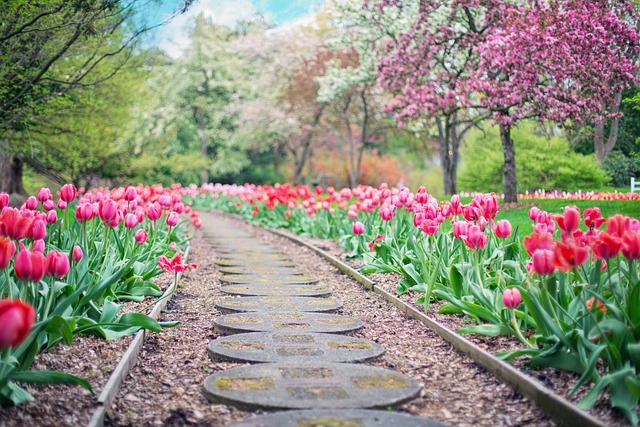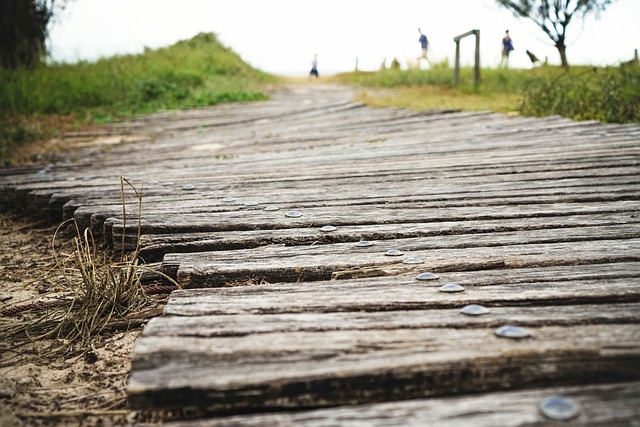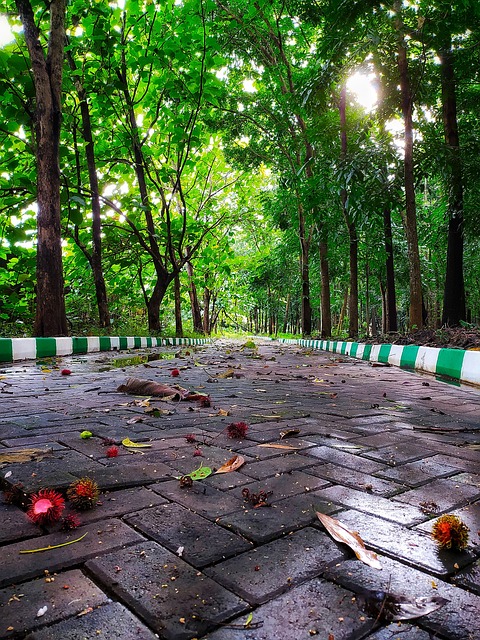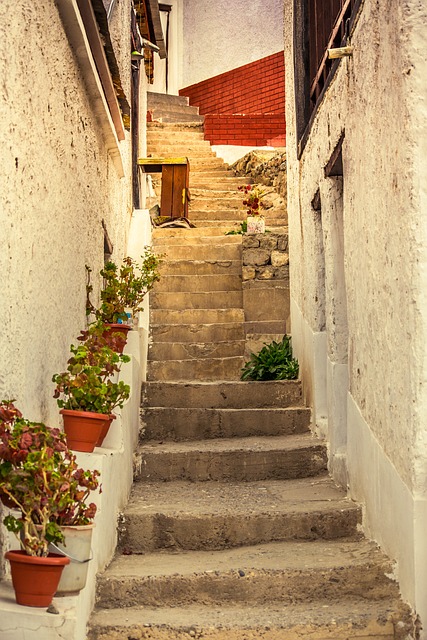Incorporating walkways into landscape design significantly enhances outdoor spaces by creating inviting and relaxing environments that encourage exploration. The design of these pathways is crucial, as they must blend with the natural topography, offer durability through choice materials like cobblestone or slate, and enhance visual interest with straight or curved routes. Proper lighting is essential for enjoyment at all times, especially at night, when it highlights the landscape's beauty and provides safety. The integration of walkways must be seamless, using consistent materials that extend into the surrounding environment for a cohesive look. Indigenous plants and stonework further harmonize the design, while strategic placement of landscaping elements ensures a smooth transition between the pathway and natural areas. Key considerations include visual continuity, safety, environmental sensitivity, and functionality, all of which contribute to creating sustainable and aesthetically pleasing walkways that are integral to the overall landscape experience.
Embark on a journey through the fusion of form and function with our exploration of seamlessly integrating pathways into landscaping design. This article delves into the art of crafting walkways that not only complement natural surroundings but also enhance outdoor spaces. From the best practices for harmonizing pathway materials with the environment to designing for both functionality and aesthetics, we will guide you through essential considerations in pathway placement and layout. Furthermore, we will uncover innovative solutions for creating smooth transitions between various landscaping areas, ensuring your outdoor experience is nothing short of seamless. Pathways become more than mere walkways; they are integral elements that elevate the ambiance of any garden or park. Join us as we explore this intricate dance between design and nature.
- Enhancing Outdoor Spaces: The Art of Integrating Walkways into Landscaping Design
- Best Practices for Harmonizing Pathway Materials with Natural Environments
- Designing for Functionality and Aesthetics: Key Considerations in Pathway Placement and Layout
- Creative Solutions for Seamless Walkway Transitions Between Different Landscaping Areas
Enhancing Outdoor Spaces: The Art of Integrating Walkways into Landscaping Design

Embarking on a landscaping project that includes the integration of walkways can transform ordinary outdoor spaces into captivating environments that invite exploration and relaxation. Strategically placed pathways not only guide movement but also become an integral part of the landscape’s design, leading visitors through a curated journey of natural beauty. The selection of materials for these walkways is paramount; they should complement the surrounding flora and fauna while providing a durable, safe passage. For instance, cobblestone or natural slate can offer both aesthetic appeal and resilience underfoot. Additionally, the alignment of the pathway with existing topography can enhance the natural flow of the landscape, creating an immersive experience that feels as though it has always been part of the environment.
The integration of walkways within a landscaping design is not merely about connectivity; it’s an opportunity to highlight key features and create visual interest throughout the space. Curved pathways can suggest a meandering, exploratory route, while straight walkways can convey a sense of purpose and directness. Lighting along these pathways at night can further enhance their presence, making the garden a place to enjoy both day and night. thoughtful planning and design ensure that the pathway becomes an artful element that enhances the overall aesthetic and functionality of the outdoor space.
Best Practices for Harmonizing Pathway Materials with Natural Environments

When integrating pathways into natural environments, selecting materials that complement the surrounding landscapes is paramount. Aesthetic harmony can be achieved by choosing pathway materials that reflect the native geology and plant life. For instance, granite or slate pavers often blend seamlessly with forested areas, while brick or concrete may serve as a subtle contrast in more open or cultivated settings. The texture and color of these materials should also be considered to avoid visual disruption; smooth, even surfaces enhance the natural flow of movement, while their hues should resonate with the dominant colors found within the landscape.
Lighting is another critical element when harmonizing pathways with natural environments. Strategic placement of solar-powered or LED lights can illuminate a walkway without detracting from the ambiance. These fixtures should be unobtrusive and, ideally, integrated into the design of the pathway itself. The goal is to create an atmosphere that feels both safe and natural, encouraging users to traverse these spaces at all times of the day or night. Additionally, incorporating eco-friendly materials and designs that minimize disturbance to the soil and local flora and fauna ensures that the pathway enhances the environment rather than detracting from it.
Designing for Functionality and Aesthetics: Key Considerations in Pathway Placement and Layout

When designing a space with walkways or pathways, the integration of functionality and aesthetics is paramount to create an environment that is both navigable and visually pleasing. The placement of pathways must consider the intended user experience; they should facilitate easy movement from one area to another without imposing on the landscape’s natural flow. A well-designed pathway complements the contours of the land, often becoming a feature in its own right through thoughtful alignment with existing flora and terrain features. The choice of materials and textures for the walkway can enhance this synergy, with options ranging from natural stone to concrete pavers, each offering a different sensory and visual impact. Moreover, the path’s width and gradient are crucial in ensuring accessibility for all users, while also preserving the landscape’s integrity.
In addition to the practical aspects of walkway design, the integration of lighting elements along the pathway can significantly influence the ambiance after dusk. Strategic placement of lights not only aids safety but also accentuates the natural beauty of the surrounding environment. The interplay between light and shadow on the paths can transform the space into a serene retreat or an inviting promenade, depending on the desired mood and the setting’s context. This thoughtful design approach ensures that the walkway serves as both a functional element and a harmonious component of the overall landscape aesthetic.
Creative Solutions for Seamless Walkway Transitions Between Different Landscaping Areas

To achieve a cohesive and harmonious outdoor space, integrating walkways with varying landscaping areas demands thoughtful planning and creative solutions. A seamless transition between these areas not only enhances aesthetic appeal but also facilitates easy navigation for visitors. One effective approach is to use consistent materials across the walkway and adjacent landscape borders. This visual continuity can be achieved by extending the pavers from the pathway into the surrounding greenery, subtly demarcating the space while maintaining an unbroken flow. Lighting design plays a pivotal role as well; strategically placed LED lights can accentuate the transition points, ensuring safety and guiding users through the landscape after dusk.
Incorporating curved walkways with landscaping elements that blend into the natural contours of the land can create an almost imperceptible transition from one area to another. Curvilinear pathways often evoke a sense of tranquility and can be complemented by indigenous plants or stonework that naturally merges with the surrounding environment. The use of consistent textures, colors, and materials in both the walkway and landscape design contributes significantly to achieving this seamless integration. Additionally, thoughtful landscaping design elements like raised beds or retaining walls can provide a smooth transition from the hardscape to softscape, creating an inviting and unobtrusive passage throughout the property.
In conclusion, integrating walkways into landscaping is a multifaceted endeavor that requires a blend of artistry and practicality. By thoughtfully considering the harmony between materials, the functionality for users, and the overall aesthetic within various landscape areas, one can create pathways that enhance outdoor experiences rather than detract from them. The seamless transition from one environment to another becomes not just an afterthought but a pivotal element in the design process. As outlined in this article, ‘Enhancing Outdoor Spaces: The Art of Integrating Walkways into Landscaping Design,’ understanding best practices for material selection and design layout ensures that every step taken along these pathways is a testament to thoughtful and sustainable landscape architecture. Homeowners and designers alike can take pride in the fact that with careful planning, walkways and landscaping can coalesce to create an inviting and cohesive outdoor experience that stands the test of time.
